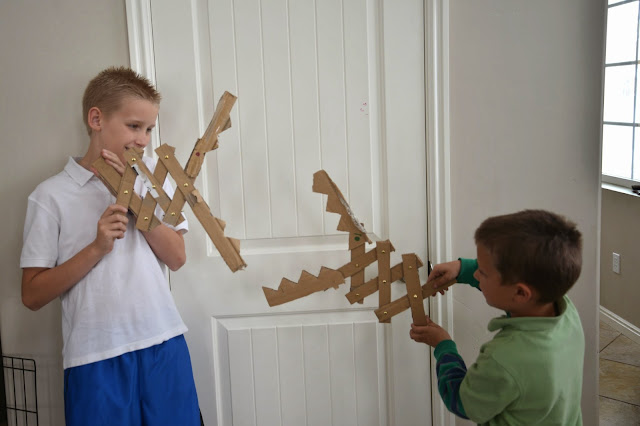Our robot celebration was one of our best ever—if I do say so myself. :) I am not much of a "party planner" so the bar was set very low, but we had so much fun! The older boys made themselves into robots out of old boxes we had lying around. They went around talking in robot voices and it was very cute. They also printed out a bunch of pictures of our favorite robots, and hung them up to make a "Wall of Robots" in the kitchen.
Half the fun was getting ready for the party. We made a few box robots as decorations.
I had Abraham help me make these little tin-can robots for all the other children. We used them to hold silverware at dinner, and then the children used them for keeping various little treasures in.
Malachi drew some robot pictures to put up on the wall.
If you search "Robot Party" on Pinterest, you will find tons of great party ideas, nearly all of them more beautiful and elaborate than I felt confident trying to re-create. But a common theme was a "Build-a-bot" station where the children could make robots out of various things. Sometimes they used rice crispie treats as a base, or sandwiches, or whatever. We decided to use toothpicks and marshmallows and a few little candies as the robot components:
The children made some cute robots.
We had a good robot-y dinner based on other ideas from pinterest. To be specific:
- Pineapple Smoothie or "motor oil"
- Screw-shaped pasta with mizithra cheese
- Small corn chips or "microchips" (the mini chocolate chips we used to "build-a-bot" were even smaller, so we called those "nanochips" :))
- Cheez-its crackers or "washers"
- Almonds or "nuts." I saw lots of "nuts-and-bolts" trail mix/chex mix ideas, but the crackers really look more like washers than bolts, don't they?
- Peas or "fuel cells." This one is the weak link since they don't really look much like batteries. But maybe like those small button kind?
And this grand robot donut "cake" for dessert! We thought he was so funny and cute. I got the brilliant idea here.
We watched "Big Hero 6" after dinner, and I made one of these little slinky "robots" (as pictured here: no instructions, but easy enough to figure out) for each of the kids. (You can get a bunch of slinkies fairly cheaply here.) They ate their rolos and mints and tic-tacs during the movie and thought it was the most exciting day ever.
Other movies we considered: "Wall-E" and "The Iron Giant." But we loved "Big Hero 6."
This was an awesome unit! We learned so much, and we didn't want it to end!



















































